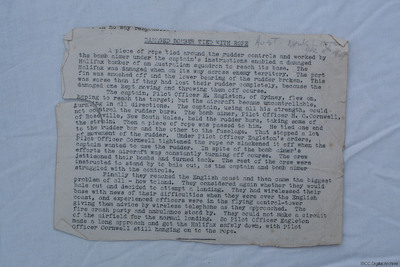Damage bomber tied with rope
Title
Damage bomber tied with rope
Description
Relates how an Australian squadron Halifax with a damaged fin was successfully brought home with rope tied onto the rudder bar and the bomb aimer using it to operate the rudder under pilot's instructions. Annotated 'Aust newsletter April 11 1944'.
This item was sent to the IBCC Digital Archive already in digital form. No better quality copies are available.
This item was sent to the IBCC Digital Archive already in digital form. No better quality copies are available.
Temporal Coverage
Language
Type
Format
One page typewritten documet
Conforms To
Publisher
Rights
This content is available under a CC BY-NC 4.0 International license (Creative Commons Attribution-NonCommercial 4.0). It has been published ‘as is’ and may contain inaccuracies or culturally inappropriate references that do not necessarily reflect the official policy or position of the University of Lincoln or the International Bomber Command Centre. For more information, visit https://creativecommons.org/licenses/by-nc/4.0/ and https://ibccdigitalarchive.lincoln.ac.uk/omeka/legal.
Contributor
Identifier
SWeirG19660703v060028-0001
Transcription
[inserted] AUST. NEWS LETTER APR 11th 1944 [/inserted]
[underlined] DAMAGED BOMBER TIED WITH ROPE [/underlined]
A piece of rope tied around the rudder controls and worked by the bomb aimer under the captain’s instructions enabled a damaged Halifax bomber of an Australian squadron to reach its base. The Halifax was damaged when on its way across enemy territory. The port fin was smashed off and the lower bearing of the rudder broken. This was worse than if they had lost their rudder completely, because the damaged one kept moving and throwing them off course.
The captain, Pilot Officer E. Eagleton, of Sydney, flew on, hoping to reach the target; but the aircraft became uncontrollable, turning in all directions. The captain, using all his strength, could not control the rudder bars. The bomb aimer, Pilot Officer H.C. Cornwell, of Roseville, New South Wales, held the rudder bars, taking some of the strain. Then a piece of rope was passed to him. He tied one end to the rudder bar and the other to the fuselage. That stopped a lot of movement of the rudder. Under Pilot Officer Eagleton’s orders, Pilot Officer Cornwell tightened the rope or slackened it off when the captain wanted to use the rudder. In spite of the bomb aimer’s efforts the aircraft was constantly turning off course. The crew jettisoned their bombs and turned back. The rest of the crew were instructed to stand by to bale out, as the captain and bomb aimer struggled with the controls.
Finally they reached the English coast and then came the biggest problem of all – how to land. They considered again whether they would bale out and decided to attempt a landing. They had wirelessed their base with news of their difficulties when they were over the English coast, and experienced officers were in the flying control-tower giving them advice by wireless telephone as they approached. The fire crash party and ambulance stood by. They could not make a circuit of the airfield for the normal landing. So Pilot Officer Eagleton made a long approach and got the Halifax safely down, with Pilot Officer Cornwell still hanging on to the rope.
[underlined] DAMAGED BOMBER TIED WITH ROPE [/underlined]
A piece of rope tied around the rudder controls and worked by the bomb aimer under the captain’s instructions enabled a damaged Halifax bomber of an Australian squadron to reach its base. The Halifax was damaged when on its way across enemy territory. The port fin was smashed off and the lower bearing of the rudder broken. This was worse than if they had lost their rudder completely, because the damaged one kept moving and throwing them off course.
The captain, Pilot Officer E. Eagleton, of Sydney, flew on, hoping to reach the target; but the aircraft became uncontrollable, turning in all directions. The captain, using all his strength, could not control the rudder bars. The bomb aimer, Pilot Officer H.C. Cornwell, of Roseville, New South Wales, held the rudder bars, taking some of the strain. Then a piece of rope was passed to him. He tied one end to the rudder bar and the other to the fuselage. That stopped a lot of movement of the rudder. Under Pilot Officer Eagleton’s orders, Pilot Officer Cornwell tightened the rope or slackened it off when the captain wanted to use the rudder. In spite of the bomb aimer’s efforts the aircraft was constantly turning off course. The crew jettisoned their bombs and turned back. The rest of the crew were instructed to stand by to bale out, as the captain and bomb aimer struggled with the controls.
Finally they reached the English coast and then came the biggest problem of all – how to land. They considered again whether they would bale out and decided to attempt a landing. They had wirelessed their base with news of their difficulties when they were over the English coast, and experienced officers were in the flying control-tower giving them advice by wireless telephone as they approached. The fire crash party and ambulance stood by. They could not make a circuit of the airfield for the normal landing. So Pilot Officer Eagleton made a long approach and got the Halifax safely down, with Pilot Officer Cornwell still hanging on to the rope.
Collection
Citation
“Damage bomber tied with rope,” IBCC Digital Archive, accessed July 27, 2024, https://ibccdigitalarchive.lincoln.ac.uk/omeka/collections/document/34515.
Item Relations
This item has no relations.

